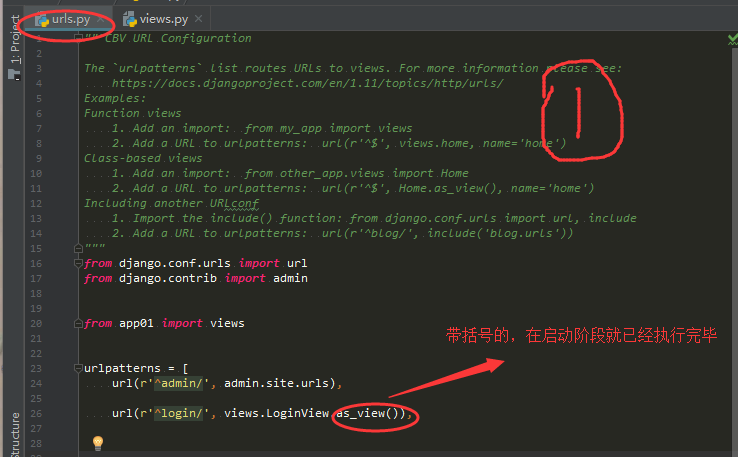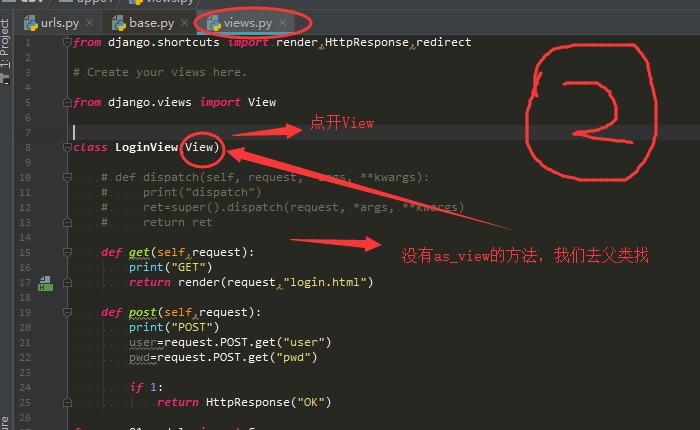python3-开发进阶Django-CBV和FBV及CBV的源码分析
一、CBV和FBV
全称应该是class base views 和function base views
理解起来应该就是基于类的视图函数和基于函数的视图函数
FBV
应该是我目前最常用的一种方式了,就是给每一个views里的功能添加自己专用的方法。例如如果要对网页进行get访问,然后通过获得request中post方式传递的form表单获取数据。
from django.http import HttpResponse def login(request):
if request.method == 'GET':
return HttpResponse('OK1') if request.method =="POST":
return HttpResponse('OK2')
。。。
CBV
但是这种方法,看起来有点臃肿,查看代码的时候不容易看清楚你的post请求get请求是在哪里处理的,所以就有了CBV的处理方法。
在views文件中:
from django.views import View
class LoginView(View):
def get(self,request):
return render(request,"login.html")
def post(self,request):
user=request.POST.get('user')
pwd=request.POST.get('pwd'))
if Turn: #假使验证成立
return HttpResponse("OK3")
在CBV的使用中,需要调用父类View,它会在源码里解释这个CBV的应用范围,以及运作原理。
在urls文件中:
from app01 import views
urlpatterns = [
url(r'^admin/', admin.site.urls),
url(r'^login/$',views.LoginView.as_view()),
# url(r'^login/$',views.login)
]
综上所述:
我们可以知道设置一个CBV方法,要做的就是,在views里创建一个类,这个类的父类一定得是View,而且在urls设置的时候,url指向的不再是一个函数名,而是你定义的类的.as_view()方法
运行起来之后,会发现当向login.html这个url发送get请求的时候,成功,发送post请求的时候,也成功,并且有相应的返回值。
二、原理
翻看源码,实现以上功能的核心,其实都在那个被继承的父类View里:
class View(object):
"""
Intentionally simple parent class for all views. Only implements
dispatch-by-method and simple sanity checking.
""" http_method_names = ['get', 'post', 'put', 'patch', 'delete', 'head', 'options', 'trace'] def __init__(self, **kwargs):
"""
Constructor. Called in the URLconf; can contain helpful extra
keyword arguments, and other things.
"""
# Go through keyword arguments, and either save their values to our
# instance, or raise an error.
for key, value in six.iteritems(kwargs):
setattr(self, key, value) @classonlymethod
def as_view(cls, **initkwargs):
"""
Main entry point for a request-response process.
"""
for key in initkwargs:
if key in cls.http_method_names:
raise TypeError("You tried to pass in the %s method name as a "
"keyword argument to %s(). Don't do that."
% (key, cls.__name__))
if not hasattr(cls, key):
raise TypeError("%s() received an invalid keyword %r. as_view "
"only accepts arguments that are already "
"attributes of the class." % (cls.__name__, key)) def view(request, *args, **kwargs):
self = cls(**initkwargs)
if hasattr(self, 'get') and not hasattr(self, 'head'):
self.head = self.get
self.request = request
self.args = args
self.kwargs = kwargs
return self.dispatch(request, *args, **kwargs)
view.view_class = cls
view.view_initkwargs = initkwargs # take name and docstring from class
update_wrapper(view, cls, updated=()) # and possible attributes set by decorators
# like csrf_exempt from dispatch
update_wrapper(view, cls.dispatch, assigned=())
return view def dispatch(self, request, *args, **kwargs):
# Try to dispatch to the right method; if a method doesn't exist,
# defer to the error handler. Also defer to the error handler if the
# request method isn't on the approved list.
if request.method.lower() in self.http_method_names:
handler = getattr(self, request.method.lower(), self.http_method_not_allowed)
else:
handler = self.http_method_not_allowed
return handler(request, *args, **kwargs) def http_method_not_allowed(self, request, *args, **kwargs):
logger.warning(
'Method Not Allowed (%s): %s', request.method, request.path,
extra={'status_code': 405, 'request': request}
)
return http.HttpResponseNotAllowed(self._allowed_methods()) def options(self, request, *args, **kwargs):
"""
Handles responding to requests for the OPTIONS HTTP verb.
"""
response = http.HttpResponse()
response['Allow'] = ', '.join(self._allowed_methods())
response['Content-Length'] = ''
return response def _allowed_methods(self):
return [m.upper() for m in self.http_method_names if hasattr(self, m)]
从源码中我们可以看到。这个CBV的核心类,是为了处理各种请求服务的。其中有一个list来存放这些请求,并且指向他们应该实现的函数功能。
再补充一点,在CBV创建类方法的时候,一定要携带一个request参数。而这个参数里面就携带了request.method.lower(),通过反射,CBV函数自然能处理这些method对应的请求。
三、逻辑过程
看源码的准则就看,看自己看的懂得代码,应为源码的有些高深的设置,我们先阶段还不需要去了解.
首先,不管cbv还是fbv,在url中都是用户访问请求,才回去执行相应的视图函数,
cbv在启动项目的时候,已经在LoginView中执行一段骚操作的得到一个函数名,我们现在就来看看:

首先我们要明确的一点就是一个类.属性或方法,首先在自己那找,找不到继承的父类找。所以不能直接点。as_view,
先去类LoginView中找看看有,有没有方法:

点开View,我们找到as_view方法,发现是类方法,
前面过程做了什么我们不管,返回值只是返回一个view,调用view函数,我们去看view函数,
view函数最后返回self.dispacth,这里要注意!!!这个self.dispacth,self是谁,self我们看代码发现是LoginView类,
还是那个准则,调用属性方法,现在自己那边找,没有再找父类。

因为LoginView中没有dispath这方法,所以还是执行的父类的dispath方法:

注意点:还是在调用某个方法时,我们一定要确定是谁去调用这个方法!找方法一定先找自己的,没有再去父类找!
四、思考自定义的dispatch
既然在上面我们查看源码的时候已经发现,导向专门的method操作的函数是dispatch,而且每个CBV类的父类都是View,那我能不能在这个dispatch里面做一些定制化操作,
继承父类的dispatch
def dispatch(self, request, *args, **kwargs):
obj=super(login,self).dispatch(request, *args, **kwargs)
return obj
# 由于父类的dispatch最后返回了一个handle,也就是一个返回值,所以在继承的时候也应该提供一个返回值装饰化这个dispatch
def dispatch(self, request, *args, **kwargs):
print('123‘)
obj=super(login,self).dispatch(request, *args, **kwargs)
print('')
return obj反馈的效果:
不管是什么方法请求,都必须要打印123,456
总的来说,这个只是一个简单的示范处理,如果需要对过来的请求做更多的润色,还需要在这个继承动作前后做更多工作。需要知道的是,他和装饰器略微不懂,那就是他可以共享这个dispatch的request,并且对他进行工作
最新文章
- Python 局部变量与全局变量
- android 开发 gradle 自己会容易混淆的东西
- Activity生命周期(深入理解)
- ios获取CELLID,LAC等信息方法
- 重新理解JS的6种继承方式
- 在iOS 8中使用UIAlertController
- IOS的UI基础01
- CHECKBOX_CHECKED built-in in Oracle D2k Forms
- c# 将PPT转换成HTML
- Spark SQL  inferSchema实现原理探微(Python)
- C51的编程规范
- jmake 编译当前目录所有c/c++单文件
- Android之Bmob移动后端云服务器
- 【原】无脑操作:Windows下搭建Kafka运行环境
- (二 -3-1) 天猫精灵接入Home Assistant-自动发现Mqtt设备--灯系列 实战
- 15、JDBC-CallableStatement
- Oracle中为表设置自动增长的标识列
- JavaWeb学习 (十七)————JSP属性范围
- phantomjs 解码url
- shiro入门实例,基于ini配置